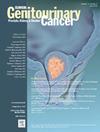临床淋巴结阴性膀胱癌行根治性膀胱切除术患者隐匿淋巴结累及的临床和病理预测因素。
IF 2.7
3区 医学
Q3 ONCOLOGY
引用次数: 0
摘要
背景:临床淋巴结阴性(cN0)膀胱癌(BC)患者的隐匿病理淋巴结累及仍然是一个诊断挑战。我们评估cT1-4N0M0 BC患者接受根治性膀胱切除术和盆腔淋巴结清扫(RC-PLND)时淋巴结阳性(pN+)的预测因素。方法:我们纳入了2004年2月至2020年10月期间接受RC-PLND的cT1-4N0M0 BC患者。将患者分为pN+和pN0。使用描述性统计总结基线特征。Logistic回归模型和多变量分析估计了pN+状态的比值比(OR)。Kaplan Meier分析和多变量Cox比例风险模型分析了无复发生存期(RFS)和总生存期(OS)。结果:440例患者被评估,其中81% (n = 359)为pN0, 17% (n = 74)为pN+。大多数为男性(80%),白人(88%),中位年龄为71岁。大多数临床T2(55%)和T1(25%)病变。TURBT淋巴血管侵犯(LVI) (OR 2.62, P = 0.04)、手术切缘阳性(OR 16.77, P < 0.001)和≥cT2疾病(OR 1.89, P = 0.04)出现pN+的几率较高。与pN0患者相比,pN+患者更容易出现复发(HR 7.67, P < 0.001)或死亡(HR 3.26, P < 0.001)。术前肾积水预示较差的RFS (HR 1.76, P = 0.011)和OS (HR 1.55, P = 0.07)。阳性手术切缘(HR 2.34, P = 0.008)和术前肾功能(HR 1.50, P = 0.004)预示较差的OS。结论:阳性手术切缘、LVI和≥cT2疾病强烈预测cT1-4N0M0 BC患者的pN+表现。术前变量可以为手术中淋巴结阳性发现风险较高的患者提供治疗信息。本文章由计算机程序翻译,如有差异,请以英文原文为准。
Clinical and Pathological Predictors for Occult Lymph Node Involvement in Patients With Clinical Node-Negative Bladder Cancer Undergoing Radical Cystectomy
Background
Occult pathological lymph node involvement in patients with clinical node-negative (cN0) bladder cancer (BC) remains a diagnostic challenge. We evaluate predictors of lymph node positivity (pN+) in patients with cT1-4N0M0 BC undergoing radical cystectomy and pelvic lymph node dissection (RC-PLND).
Methods
We included patients with cT1-4N0M0 BC undergoing RC-PLND from February 2004 through October 2020. Patients were classified as pN+ vs. pN0. Baseline characteristics were summarized using descriptive statistics. Logistic regression models and multivariable analysis estimated odds ratios (OR) for pN+ status. Kaplan Meier analysis and multivariable Cox proportional hazards models analyzed recurrence-free survival (RFS) and overall survival (OS).
Results
440 patients were evaluated, of which 81% (n = 359) had pN0 and 17% (n = 74) had pN+ disease. Most were male (80%), white (88%), and had a median age of 71 years. Most had clinical T2 (55%) and T1 (25%) disease. Lymphovascular invasion (LVI) on TURBT (OR 2.62, P = .04), positive surgical margins (OR 16.77, P < .001), and ≥ cT2 disease (OR 1.89, P = .04) had higher odds of pN+ status. pN+ patients were more likely to suffer recurrence (HR 7.67, P < .001) or death (HR 3.26, P < .001) compared to pN0 patients. Preoperative hydronephrosis predicted worse RFS (HR 1.76, P = .011) and OS (HR 1.55, P = .007). Positive surgical margins (HR 2.34, P = .008) and preoperative renal function (HR 1.50, P = .004) predicted worse OS.
Conclusion
Positive surgical margins, LVI, and ≥ cT2 disease strongly predict pN+ findings in patients with cT1-4N0M0 BC. Preoperative variables can inform treatment for patients with a higher risk for positive lymph node findings at surgery.
求助全文
通过发布文献求助,成功后即可免费获取论文全文。
去求助
来源期刊

Clinical genitourinary cancer
医学-泌尿学与肾脏学
CiteScore
5.20
自引率
6.20%
发文量
201
审稿时长
54 days
期刊介绍:
Clinical Genitourinary Cancer is a peer-reviewed journal that publishes original articles describing various aspects of clinical and translational research in genitourinary cancers. Clinical Genitourinary Cancer is devoted to articles on detection, diagnosis, prevention, and treatment of genitourinary cancers. The main emphasis is on recent scientific developments in all areas related to genitourinary malignancies. Specific areas of interest include clinical research and mechanistic approaches; drug sensitivity and resistance; gene and antisense therapy; pathology, markers, and prognostic indicators; chemoprevention strategies; multimodality therapy; and integration of various approaches.
 求助内容:
求助内容: 应助结果提醒方式:
应助结果提醒方式:


